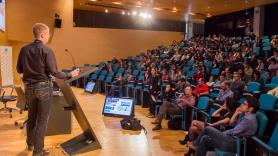2. Histones, more than just a pearl necklace
It may seem simple, but there is a whole orchestra that has to be coordinated so our two arms will be in the right spot, one on either side of the body, or for us to have two symmetrical legs. And for all of this to come about from a single cell after the joining of an egg and a sperm.
Part of this orchestra is the histones, a group of proteins that DNA wraps around in clumps, making it look like a pearl necklace. Depending on how they move through the DNA and how tightly it is wrapped, histones allow some genes to be expressed and others, not. This is done differently for each cell and depending on their point in the lifecycle: regulation in time and space.
One of the most well known roles is in regulating Hox genes, located on the edge of the genome, which establish distribution of organs and extremities. (Alterations to the Hox genes can cause flies to be born with legs instead of antennas). To regulate them, there are two main protein groups, Polycomb and Trithorax. Both add marks (methyl groups) to amino acids in the H3 histone. Polycomb to amino acid 27 and Trithorax to amino acid 4. The result? The first represses and the second activates. During the concert, organs and extremities develop according to plan in the pre-established location.
When something is so important to growth, it’s logical that something bad would happen if it stopped working. That’s what Ali Shilatifard, professor of biochemistry and molecular genetics at Northwestern University in Chicago, explained. Translocations (rearrangement of chromosomes) affecting MLL genes (homolog of the Trithorax group) cause leukemia with a very bad prognosis in children. And alterations in the Polycomb group seem to be behind some gliomas, particularly aggressive brain tumors. This is why Shilatifard believes that Polycomb is a clear “candidate to treat these tumors.”
All of these marks are different for each cell type. This is why it is so important to understand how they work. For example, it’s not possible to generate pluripotent cells (which can turn into many other types of cells) from mature, stable cells, like those in the skin. These are called iPS cells, the great hope for regenerative medicine which Japanese scientist Yamanaka won the Nobel Prize for in 2012. But certain epigenetic barriers, in part due to histones, stop them from being totipotent, or completely flexible in becoming any sort of tissue, as happens with the first cell, the zygote.
This is the topic of study of Maria Elena Torres-Padilla, group leader at the Institut de Génétique et de Biologie Moléculaire et Cellulaire in Strasbourg. Her definition of totipotency is “A cell’s ability to create a complete organism all on its own.” This ability is lost almost immediately, when the zygote has divided just a couple of times, but her group has obtained very similar cells by just modifying a gene in later embryo cells. They still don’t know if they are truly totipotent, even though they seem to be. But Torres-Padilla wondered if they could be created in the laboratory and “The answer is yes,” she said.
It’s not all about histone marks, the histones themselves are also important. There are more than thirty different types, with different properties. For example, one called macroH2A. As explained by Marcus Buschbeck, group leader at the Institute for Leukemia Research, they only make up 1% or 2% of all histones, but they stabilize the whole epigenome, as when they are missing, it becomes totally unorganized. Or H2AZ, studied by Sandra B. Hake at the University of Munich, which participates in both disparate and related process like gene regulation, DNA repair, ageing and some tumors.
Epigenetics is related to genetics, but also to epigenetics itself. Danny Reinberg, of the Howard Hughes Medical Institute in New York and one of the top experts in his field worldwide, showed how some non-coding RNA activates gene expression by inhibiting the Polycomb group. And how genetic mutations in proteins that go towards the methylated areas of DNA (epigenetics) cause serious neurological disorders and even autism in young girls, as seen in Rett syndrome.



